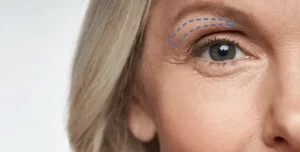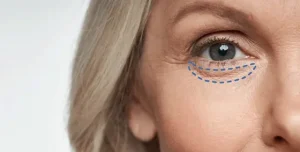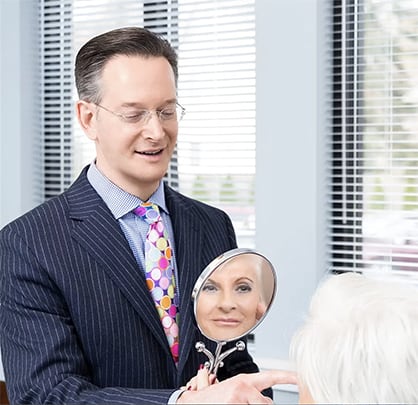Blepharoplasty (Eyelid Surgery)
Eyelid surgery is a delicate procedure that removes excess skin, muscle, and fat around the eyes, restoring a vibrant, rejuvenated appearance.
The eyes are the windows to the soul, and sagging upper eyelids or bags under the eyes can make a person appear aged and tired. The earliest signs of aging appear in the eyelids. Droopy, puffy eyelids can add years to your facial appearance and, in some cases, can even affect peripheral vision. Unfortunately, at-home treatments are no match for certain signs of aging in the eye area. Eyelid surgery can improve the signs of aging around the eyes and dramatically boost self-confidence.
With decades of experience in facial plastic surgery and over 4,000 eyelid surgeries under his belt, Dr. Jonathan Pontell performs blepharoplasty on both the upper and lower eyelids. Dr. Catherine Weng is also extensively skilled and experienced with this procedure and offers surgical options for both eyelid regions. They provide expert-level care using the latest surgical advancements in state-of-the-art facilities. To schedule an appointment, call our Philadelphia office at (610) 688-7100, or fill out our contact form at your leisure.
Topics On This Page:
- What Is Blepharoplasty?
- Benefits of Eyelid Surgery
- Am I a Good Candidate for Blepharoplasty?
- Blepharoplasty Before-and-After Photos
- Personal Consultation
- Blepharoplasty Preparation
- Blepharoplasty Procedure
- Blepharoplasty Recovery & Results
- What About Revision Eyelid Surgery?
- How Much Does Blepharoplasty Cost?
- Additional Blepharoplasty FAQs
- References
What Is Blepharoplasty?
Eyelid surgery is a perfect option for correcting bags, drooping skin excess, fine lines, wrinkles, and a “hollow” appearance under the eyes. Upper blepharoplasty can lift the eyelids to correct sagging. Lower blepharoplasty can smooth under-eye bags for a fully refreshed, awake and alert, more youthful look.
Upper Blepharoplasty
 Upper lid blepharoplasty is commonly performed on patients with aging eyelids and sagging skin. Upper eyelid skin sagging develops in some patients in their 30’s but others don’t see this aging process until they reach their 50’s.
Upper lid blepharoplasty is commonly performed on patients with aging eyelids and sagging skin. Upper eyelid skin sagging develops in some patients in their 30’s but others don’t see this aging process until they reach their 50’s.
For this procedure, our surgeon starts by marking the eyelid after testing how much tissue can be safely removed to achieve optimal results. Our doctor removes an ellipse of skin from the upper eyelid in the deep part of the upper lid crease. Some patients benefit from a removal of a portion of the muscle that is deep to the upper eyelid skin.. After the resection is through, the eyelid is carefully sutured across the natural crease so the scar remains easily concealable. (1)
Lower Blepharoplasty
 Performed to reduce the look of severe eye bags, lower blepharoplasty starts with our doctor marking out the bags. Once the amount of fatty tissue and skin and muscle being removed is determined, our surgeon typically uses a local anesthetic to numb the area, then carefully makes the incisions. Some patients only need an internal lower eyelid incision (transconjunctival) and some need an external incision also. If an external incision is necessary, the lower eyelid is sutured with a running stitch. (2)
Performed to reduce the look of severe eye bags, lower blepharoplasty starts with our doctor marking out the bags. Once the amount of fatty tissue and skin and muscle being removed is determined, our surgeon typically uses a local anesthetic to numb the area, then carefully makes the incisions. Some patients only need an internal lower eyelid incision (transconjunctival) and some need an external incision also. If an external incision is necessary, the lower eyelid is sutured with a running stitch. (2)
Feel free to give our blog a read to learn more about the procedures our facial plastic surgeons perform.

Benefits of Eyelid Surgery
Blepharoplasty can benefit patients by:
- Reducing Fine Lines and Wrinkles – Blepharoplasty encompasses the tightening and removal of surplus fat, muscle, and skin surrounding the eyes to diminish the visibility of fine lines and wrinkles and get smooth contours. Following this procedure, patients can relish in the presence of smoother skin and a rejuvenated appearance.
- Creating a Younger, More Alert Appearance – Surplus skin and drooping tissues around the eyes can contribute to a tired, saddened, or prematurely aged appearance. Through the removal of displaced fat, and excess skin, and the tightening of sagging muscles, patients can anticipate a more revitalized and youthful look, characterized by eyes that appear alert and rejuvenated.
- Improving Vision – While blepharoplasty is commonly associated with facial cosmetic surgery, it is worth noting that many individuals choose to undergo this procedure for vision-related reasons. When excessive skin or sagging tissues on the upper eyelids obstruct the pupil, it can impact one’s vision. This procedure effectively resolves this issue by eliminating droopy eyelid skin, thus correcting vision obstruction.
Whether you have recently noticed your under-eye bags getting worse, you have always found your drooping upper eyelids unattractive, or if your field of vision is obscured, Dr. Pontell or Dr. Weng will be happy to determine if blepharoplasty is right for you.
Am I a Good Candidate for Blepharoplasty?
Patients with excess sagging skin in the upper or lower eyelids that cause fine lines, wrinkles, or under-eye bags may be good candidates for blepharoplasty. Patients must be non-smokers (or willing to quit one month before and after surgery), in good health, and have realistic expectations to ensure optimal results. Some patients who need eyelid surgery are also good candidates for a facelift and brow lift also.
Personal Consultation
 Prior to your procedure, you will meet with Dr. Pontell or Dr. Weng to evaluate your facial structure, goals, and concerns. They will examine the structures of your eyelids, eyebrows, and forehead to determine how to create the most aesthetically pleasing outcome. Once they completely understand your goals, our facial plastic surgeon will suggest the appropriate technique for your facial anatomy.
Prior to your procedure, you will meet with Dr. Pontell or Dr. Weng to evaluate your facial structure, goals, and concerns. They will examine the structures of your eyelids, eyebrows, and forehead to determine how to create the most aesthetically pleasing outcome. Once they completely understand your goals, our facial plastic surgeon will suggest the appropriate technique for your facial anatomy.
Preparation
To be ready for your eyelid surgery, patients must:
- Quit all consumption of tobacco and nicotine products
- Refrain from taking NSAIDs like ibuprofen for 2 weeks before and after surgery
- Adjust any current medications at Dr. Pontell’s or Dr. Weng’s request
- Avoid certain herbal remedies that may interfere with the healing process
Blepharoplasty is an outpatient procedure, meaning you are required to find a trusted person who is able to drive you to and from your surgery. You may also want them to stay with you for the first couple of days after surgery.
Blepharoplasty Procedure
Blepharoplasty surgery is typically performed under local anesthesia, IV sedation, or general anesthesia, depending on the extent of the procedure and your goals. For upper eyelid surgery, an incision is made within the natural fold of the upper eyelid. For lower eyelid surgery patients who only need fat removed, our doctor may only need to make an internal (transconjunctival) incision within the lower eyelid.
When excess skin also needs to be removed from the lower eyelid, a small incision is made just under the lower eyelashes. Fat and sagging skin are removed through the incisions, and muscles may be lifted or tightened to provide more flattering eyelid contours. If the lower eyelid muscle needs to be lifted, the procedure is known as a Skin Muscle Flap. Repositioning the eyelids brightens the eyes for a more rejuvenated overall complexion.
Recovery & Results
After your procedure, our surgeon will provide you with instructions on how to care for your surgical wounds properly. You should use iced saline gauze pads and ointments to help to ease swelling and discomfort. Patients will typically experience some minor discomfort from surgery; however, any pain can be alleviated with medication prescribed by Dr. Pontell or Dr. Weng.
Expect to experience swelling and bruising after your procedure. This is normal and typically resolves within two weeks. You will be able to return to your usual activities about two weeks after your surgery.
The average patient returns to work in about one week. Because incisions are hidden along the natural lines and creases of the eyes, the scars will fade over time. Scars generally are not visible once healing is complete.
What About Revision Eyelid Surgery?
Our facial plastic surgeon has seen many patients who have undergone an eyelid lift with another doctor and were not satisfied with the final results. This may be caused by asymmetry, problems with the height of the new crease, triple folds, and other possible complications. (3)
For the best results after eyelid surgery, patients must wait at least six months to a year after the initial blepharoplasty procedure. This allows the tissues time to heal fully and for the final results to become apparent.
How Much Does Blepharoplasty Cost?
Blepharoplasty is performed at an average cost of between $4500 and $8000. The price will vary based on the extent of the corrections needed and whether both upper and lower lids require surgery.
To receive a clearer estimate and more detailed information about eyelid surgery and what it can do for you, fill out this convenient form to schedule your private consultation. You may also call us directly at (610) 688-7100.
Additional Frequently Asked Questions About Blepharoplasty Surgery
Will I Look Like Another Person After Eyelid Surgery?
Eyelid surgery is not intended to make you look like another person but to refresh and rejuvenate your current appearance. Our doctor’s eyelid surgery procedure is highly technical and precise, removing the correct amount of fat, tissue, and skin to revive your appearance while ensuring it does not look “overdone.”
Will My Eyes Look “Pulled Back” After Blepharoplasty?
Facial plastic surgery has improved over the past few decades. The most recent and modern techniques are designed to help patients achieve natural-looking results. Dr. Pontell and Dr. Weng are experienced facial plastic surgeons who offer the latest advancements in blepharoplasty. They can help you achieve results that make you appear more youthful while maintaining your unique look.
How Difficult Is Eyelid Surgery Recovery?
Recovering from blepharoplasty is relatively straightforward. During the first few days, it is common to experience mild discomfort, swelling, and bruising around the eyes. Applying cold compresses and keeping your head elevated can help minimize these symptoms. As the healing progresses, the swelling will gradually subside, revealing the final results.
How Can I Manage Pain After Eyelid Surgery?
Dr. Pontell or Dr. Weng will prescribe pain medication to help manage any discomfort during the initial stages of recovery. It is important to follow the prescribed dosage instructions and avoid any medications that may increase bleeding or interfere with the healing process.
References
- Bhattacharjee K, Misra D, Deori N. Updates on upper eyelid blepharoplasty. Indian Journal of Ophthalmology. 2017;65(7):551. doi:https://doi.org/
- Rostami S, de la Torre JI, Czyz CN. Lower Eyelid Blepharoplasty. PubMed. Published 2021. Accessed October 11, 2023. https://www.ncbi.nlm.nih.gov/
- Cho IC. Revision Upper Blepharoplasty. Seminars in Plastic Surgery. 2015;29(3):201-208. doi:https://doi.org/






